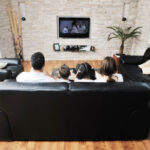Common Issues and how to fix them
Television technology has evolved dramatically over the past few decades, and one of the most popular types of TVs on the market today is the LCD TV. While these televisions are known for their high-quality visuals and long lifespan, they can still experience issues from time to time.
Introduction
LCD TVs, or Liquid Crystal Display TVs, use a combination of liquid crystals, backlighting, and color filters to produce images on the screen. Despite their many advantages, LCD TVs can still experience common faults that can be frustrating for users. Before you assume the worst and consider purchasing a new TV or calling a professional, try these simple fixes to potentially resolve the issue.
Common Faults and Fixes
No Picture, But Sound
A common problem with TVs is having sound but no picture. Here are some simple ways to address this issue:
Check the video input
Ensure the correct video input is selected on your TV. Use the Input or Source button on your remote control to cycle through available inputs.
Examine the cables
Inspect the HDMI, SCART, or other video cables connecting your TV to your devices. Ensure they are securely connected and free of damage. If you suspect a faulty cable, replace it with a new one.
Reset the TV
Unplug your TV from the power source, wait for at least 30 seconds, and then plug it back in. This can often resolve minor issues.
Update the software
Ensure your TV’s software is up-to-date. Check the manufacturer’s website for any available updates.
No Sound, But Picture
If you have a clear picture but no sound, consider these troubleshooting tips:
Check the audio settings
Ensure your TV’s audio settings are correctly configured. Verify that the volume is turned up, and the mute button is not activated
Inspect the cables
Check the audio cables, such as HDMI or optical cables, connecting your TV to external devices. Ensure they are securely connected and free of damage.
Test external speakers
If you’re using an external sound system, ensure it is turned on and the correct input is selected. Test the speakers with another device to rule out speaker issues.
Lines or Distorted Image
Lines or a distorted image on your TV screen can be frustrating. Try these simple solutions:
Check the cables
Loose or damaged cables can cause lines or a distorted image. Check all connections and replace any damaged cables.
Reset your TV
Unplug your TV from the power source, wait at least 30 seconds, and then plug it back in.
Adjust picture settings
Navigate to your TV’s picture settings and try adjusting the sharpness, contrast, or other settings to see if this improves the image quality.
TV Turns On and Off Repeatedly
A TV that turns on and off repeatedly can be due to several factors:
Power issues
Check the power cable for damage or loose connections. Plug the TV directly into a wall socket instead of a power strip to rule out power strip issues.
Overheating
Ensure your TV has adequate ventilation to prevent overheating. Remove any obstructions and clean the vents with a soft brush or cloth.
Capacitor issues
If the problem persists, there could be an issue with the capacitors in your TV. This would require professional assistance to diagnose and repair.
Remote Control Issues
Remote control issues are quite common and can be quite frustrating when you want to kick back and enjoy your favourite shows. Here are a few common problems and their solutions:
Unresponsive buttons
If the buttons on your remote control aren’t responding, there might be dirt or debris built up underneath them. Try gently tapping the remote against your hand to dislodge any particles. If that doesn’t work, you can also use a toothpick or cotton swab with rubbing alcohol to clean around the buttons.
Dead batteries
One of the most obvious reasons your remote control may not be malfunctioning is dead batteries. To fix this, simply replace the old batteries with fresh ones. Remember to properly dispose of used batteries.
Infrared (IR) interference
In some cases, other electronics or sunlight can interfere with the IR signal between your remote control and the TV. Make sure there are no objects blocking the IR receiver on your TV, and try using the remote from different angles or distances.
Hardware fault in remote control
If you’ve tried all the above steps and your remote control is still not working, it may be a hardware fault. In this case, you may need to replace it with a new one or a universal remote control. We’re able to advise on the best replacement handset for your model of TV.










